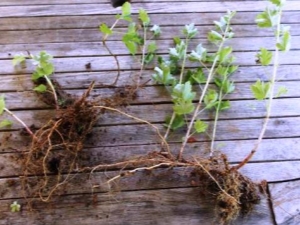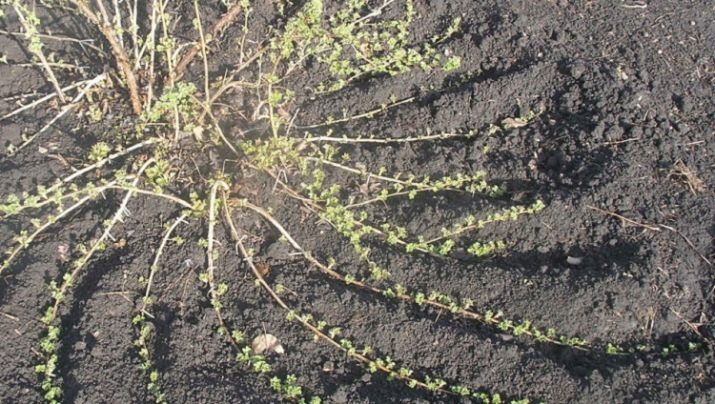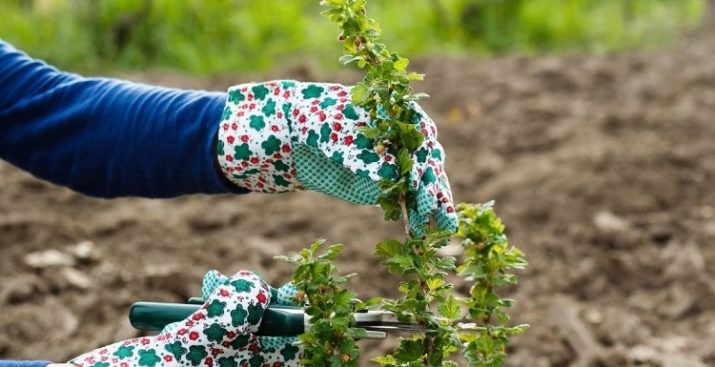How to propagate gooseberries?

It is necessary for every gardener, summer resident and gardener to understand all the subtleties of breeding garden crops, regardless of the goals that he pursues when growing plants. Whether it is breeding for private purposes or growing for the subsequent sale of seedlings. And this also applies to gooseberries, since obtaining young culture bushes is possible in several ways.
Reproduction green cuttings
In some sources, you can find another name for the garden gooseberry - northern grapes, the plant is perennial, and its berries are enriched with various vitamins and organic compounds. Therefore, the fruits are both tasty and healthy seasonal delicacy. Gardeners who cultivate it have an idea of several methods of bush reproduction, everywhere applying them in practice.
In order to increase their berry plantations, you need to choose only pure-quality crops that are completely healthy and productive.
Preparation for this important event begins in the summer, and the work is most often carried out with the arrival of spring. The selected plant needs more thorough care, including sanitary and formative pruning, timely watering and feeding, as well as in the implementation of preventive treatment measures. Using the cutting method is considered to be the most common option for obtaining new young cultures. According to most gardeners, this option is most effective for American gooseberry varieties and European hybrid crops.
The fundamental point in this issue is the correct timing of reproduction, since delay or haste can lead to negative points, for example, the slow development of the root system of young gooseberry bushes. As for green grafting, the suitable period for implementation will be early spring, usually gardeners choose the first half of May for work.
As the most suitable shrub, one should opt for a four-year-old plant; it is from its tops that one needs to take propagation material from the top young shoots. This choice is due to the properties of the lower part of such branches for reproduction.
Preparation of planting material is carried out in a certain sequence.
- In selected cuttings, it is necessary to cut off the entire lower foliage, leaving only 2-3 leaflets at the very top. After this, an incision should be made near each kidney. This method will allow plants to quickly adapt and take root.
- Next, the cuttings must be kept in water for about a day in order for the young process to be saturated with moisture in the proper amount. The use of growth stimulants is also allowed; in these compositions, the plant should be about eight hours.
- Having completed the above activities with planting material, it can be sent for boarding into an equipped mini-greenhouse with shelter. In the first two weeks, it is necessary to provide young cultures with a certain microclimate: the humidity of the air should be at the level of 90% at soil temperature not lower than + 20 ° C and the total air temperature around + 27 ° C.
After three weeks, the cuttings are already sufficiently rooted in the substrate, so they can be gradually accustomed to the usual conditions of development. During this period, you can open the shelter and leave the plants at the natural temperature, and at night again cover the cuttings. As soon as the first sprouts appear on the cuttings, the film or other covering material can be removed.
After planting, the beds with seedlings need to be moistened and loosened, and the crops also need feeding. The best option would be the use of ammonium nitrate, potassium salt and superphosphate. Competent agrotechnology will allow growing young strong gooseberry saplings at the end of the season.
Dividing bush
Since the garden gooseberry has a characteristic self-expression of individual parts, it is quite often possible to observe how the shoots of the bush form their root system. This is a particular advantage when transferring a crop to another place in the garden or plant reproduction. Usually, the division is performed after the growing season, so the gooseberry can be propagated in the summer or autumn, and also the separation is performed when the crop leaves the winter dormancy period. Such manipulations are recommended for plants whose age has not exceeded five years. The procedure for dividing the bush is as follows:
- gooseberry must be carefully dug out of the ground;
- choose young branches with their own roots, dividing the plant into several separate parts;
- The obtained independent cultures are rooted in a prepared place in the garden with the obligatory pruning of the branches, which is necessary for activating the growth of the root system.
Planted separated plants also need care, including all the mandatory work associated with berry crops. Particular attention in the spring should be given to watering the bushes, especially if the summer will stand out in heat and drought. In the case when the mother plant is divided into parts in September or later, the bushes must be prikopat and cover for wintering to avoid frosting of the culture.
This variant of plant reproduction is the simplest, and most importantly, fast, in contrast to the variant of seed gooseberry cultivation.
How does gooseberry reproduce by layering?
The process of cultivation of gooseberry branches has its own characteristics. Among the less experienced gardeners, this method has gained widespread popularity. Due to the demand for such reproduction with minimal stress on the plant in the process of horticultural manipulations with the culture. The essence of the work consists in the separation of independent seedlings with their roots. Bends are of several types:
- horizontal;
- vertical;
- arcuate.
In the first case, three or four year old plants are selected. As practice shows, the process is slightly extended in time, and the result of the work done will be to obtain up to 10 young berry plants.
The best time for the formation of layers is spring, work should be done before the beginning of the phase of bud break.
The technology of the manipulation is as follows:
- on an adult gooseberry, healthy branches are selected about one year old;
- near the shoots in the ground form special grooves with a depth of about 10 centimeters;
- selected branches are placed in recesses and fixed, while the earth is not necessary to use;
- at the time of the appearance on the branch of a new growth of about 10 centimeters in size, it is possible to powder a young branch with humus;
- 14-15 days later, the plant is spudded, and at the end of the growing season, the cuttings can be separated from the mother plant and cut into pieces based on the number of young shoots formed during this period;
- The final step is rooting of planting material to the place of further growth.
As for the more mature berry plantations, whose age has already exceeded six years, they should not be used, since the plant has almost lost its productive potential, and the work will be ineffective. In this case, it is recommended to resort to the formation of vertical layers. The work is carried out according to the following technology:
- with the arrival of heat, the old branches on the bushes must be completely cut off, the young ones must be shortened by 2/3;
- during the period of active growth of the young branches, they spud earth with them, tightly tamping up all the voids;
- in the summer it may be necessary to re-cover the branches with earth, it all depends on the degree of growth of the shoots;
- to activate the branching process, it will be necessary to pinch the tops of the layers;
- regular watering is mandatory throughout the summer;
- with the arrival of autumn, the gooseberries need to be dug, as a rule, at this time the roots have already formed their roots;
- high-grade plants are separated from the mother bush and rooted in the plot prepared for berry plantings.
The method of obtaining arcuate bends in many ways resembles the first breeding option for gooseberries. The technology of the work is as follows:
- in culture, you need to choose the strongest shoot, which must be cut and lowered into the prepared recess in the soil;
- it is necessary to strengthen it in the middle and cover it with a layer of nutritious soil;
- the extreme part is removed from the ground and fixed to any object, for example, a stick or a peg in the shape of an arc;
- spud culture and moisturize as needed;
- In the fall, you need to cut off the cuttings from the parent plant and plant on the selected area in the garden.
A gooseberry seedling obtained by arcuate layings may have smaller dimensions in comparison with the plants obtained by diverting horizontal shoots, but, as experience shows, such plants have a high viability, and also enter into the fruiting phase earlier. Most often, crops from similar bushes are harvested in the second year after rooting.
For the industrial cultivation of gooseberry seedlings, you can use another highly effective option for obtaining young plants. The technology of work is described below.
- Works are also carried out in the spring. At this time, the selected bush need to prune all available shoots. Such pruning will be an incentive for active branching of the shrub, as a result of which quite a lot of planting material can be obtained from an adult plant by the fall. All weak shoots are cut to the point of growth, the rest of the shoots are left on the mother plant until the next spring.
- Around April, the side shoots are lowered to the ground and laid in grooves with nutrient soil. Layers need to fix, cover with a layer of earth and water, if necessary, with warm distilled water.
- In summer, new shoots should form on the growth points of the shoots. When its length reaches 15 centimeters, they are sprinkled with earth to give impetus to the development of the roots.
- In the fall, shoots with cuttings are separated from the parent bush, all saplings with roots are rooted in tare and left to spend the winter in the cellar, keeping the positive temperature and humidity there at the level of 70-75%.
- In spring, the plants are transplanted into a greenhouse with a step between plants of 30 centimeters. By the fall, you can get a full-fledged culture for rooting in the garden.
Combined Ways
For breeding gooseberry varieties of different varieties rather effective method is the cultivation of combined cuttings of the plant. The essence of the method is to combine the green and stiffened parts of the plant, which take root in the holes.
Work is usually carried out in July, as the cuttings reach a height of more than half a meter, the plants are separated. This method can be used for gooseberry hybrids and any other varieties. But there are also combined cuttings, which consist of a green shoot and a part that already goes into wood. Such sprouts are an excellent option for breeding horticultural crops, since they do not need to be grown in greenhouse conditions.
The roots of such shoots can form even in ordinary water, in some cases, an additional growth factor is added to the liquid. Procurement of material occurs in May, when the green part grows to 5 centimeters. Branch escape occurs by breaking out of the old branch, leaving a fracture in the form of "heels". They resort to two more options for obtaining blanks for reproduction - the shoot is cut off from the parent bush along with the woody part of the brown growth, or the branch is cut on both sides of the sprout that is perpendicular to it.
After this, the cuttings are rooted in a wet substrate and mulched, by the fall the seedling will be ready for planting at a permanent place of cultivation.
As a rule, planting material taken from a healthy plant will become a full-fledged fruit-bearing plant, while observing simple agrotechnical measures.
The next video will focus on gooseberry propagation by cutting.


































